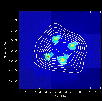- Cosmic Microwave Background anisotropy can be measured on scales less than 2 arcminutes.
- The MMA will reach about 2 microkelvin rms for a 1 arcminute beam in 1 hour
- Seeds of clusters & galaxies
- Sunyaev--Zel'dovich Effect in Clusters will provide estimates of cluster physics & peculiar motions
- Size and curvature of the Universe from the Hubble Constant and q.
- Sunyaev--Zel'dovich and X--ray data
- Expanded `CO' Tully--Fisher relation
- The MMA will reach about 2 microkelvin rms for a 1 arcminute beam in 1 hour
- Epoch of Galaxy Formation and Subsequent Galaxy Evolution
- Detect dust emission from galaxies just brighter than the Milky Way to z~20.
- CO emission from high z galaxies
- Ultraluminous galaxies to z~3
- Normal (e.g. Milky Way) galaxies to z~1
- Follow evolution of galaxies
 A Molecular Cloverleaf (100K jpg) CO (7-6) emission from
the Cloverleaf Quasar (z=2.6) at 0.9" resolution superposed on HST optical
image. Contours are multiples of 10%. MMA resolution would equal or exceed
that obtained by the HST. Image from the
Caltech Millimeter Array.
A Molecular Cloverleaf (100K jpg) CO (7-6) emission from
the Cloverleaf Quasar (z=2.6) at 0.9" resolution superposed on HST optical
image. Contours are multiples of 10%. MMA resolution would equal or exceed
that obtained by the HST. Image from the
Caltech Millimeter Array.
- Ultraluminous galaxies to z~3
- Imaging Gas in Galaxies
- Galactic Structure
- Dynamics of interacting, merging, spiral and barred galaxies
- Detailed comparison with optical & infrared
- Evolution of galaxy morphology
- Star Formation
- Imaging gas from individual star forming cores in nearby galaxies
- Role of galaxy morphology
- Role of environment
- Starbursts
- Dynamics: collisionally & bar induced starbursts
- Gas properties & star formation efficiency
- Evolution of ISM
- Trace the life cycle of molecular clouds
- Impact of star formation on molecular clouds
- The Magellanic Clouds: Unique Laboratories
- Observe large population of clouds at same distance with resolution better than 0.2 pc
- Role of environment on star formation process
- Evolutionary sequence of star formation
- Galactic Structure
- Galactic Nuclei
- The Galactic Center Source Sgr A*
- Kinematics of neutral gas on a scale of 1000 AU
- Continuum emission from Sgr A* accretion disk
- Active Galactic Nuclei
- Gas and dust properties on pc scales
- Creating & fueling AGN, circumnuclear disks
- Interaction of radio jets with ISM

 The Millimeter Array is A Project of the
The Millimeter Array is A Project of the
National Radio Astronomy Observatory
and the National Science Foundation
Back to the Science Highlights Page - The Galactic Center Source Sgr A*